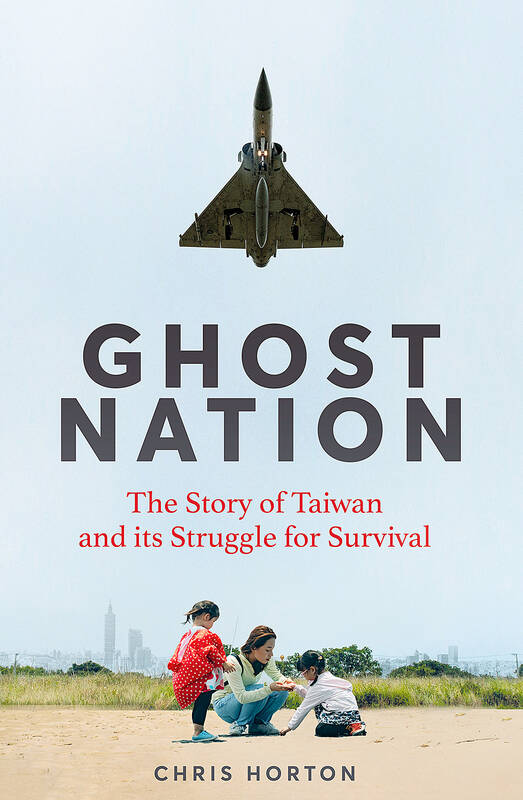As the world has raced to understand how Taiwan can be both the world’s most important producer of semiconductors while also the pin in the grenade of World War III, a reasonable shelf of “Taiwan books” has been published in the last few years. Most describe Taiwan according to a power triangle dominated by the US and China. But what of the actual Taiwanese themselves? Who are they? And should they have any say in the matter?
Chris Horton’s Ghost Nation: The Story of Taiwan and Its Struggle for Survival is perhaps the first general history of Taiwan to answer these questions and do justice to its people and their long fight to build Asia’s most vibrant democracy. Not only is it a compelling read, it’s one that is utterly crucial for understanding both Taiwan’s domestic politics and global importance today.
For the last decade, Horton has reported from Taiwan for the New York Times, the Guardian and the Atlantic, where he once described the nation’s predicament — that of an independently governed territory vital to the world economy but only given full diplomatic recognition by only about a dozen UN member states — as a “geopolitical absurdity.”

In Ghost Island, Horton covers Taiwan from disputes over ancient territorial claims to semiconductors and current tensions with Beijing, but where he really shines is in a long overdue history of Taiwan’s road to democracy.
PROTO DEMOCRACY
Proto-movements for Taiwanese self-determination emerged during the island’s Japanese colonial era — in 1923, Taiwan’s first pilot, Hsieh Wen-ta (謝文達), dropped a load of political leaflets over Tokyo as part of a campaign for local representation in government — but today Taiwan’s sense of unique identity is largely defined against the island’s occupation by Chiang Kai-shek’s (蔣介石) Chinese Nationalist Party (KMT) armies following World War II.
When Chiang retreated to Taiwan in 1949, bringing with him more than a million soldiers, bureaucrats and refugees, he established rule over a population that was by then mainly Hokkien and Hakka Chinese, immigrants from south China during the previous 300 years who’d intermixed with what was by then a small minority of indigenous Austronesian peoples.
These “native born Taiwanese,” who’d become prosperous and educated under Japanese colonial rule, were alarmed by the arriving KMT troops, a ragged, shambling bunch who were not only unsanitary — they reintroduced both bubonic plague and cholera to Taiwan — but were also horribly corrupt, looted everything in sight and spoke Chinese dialects that were to all intents completely different languages.
Tensions between the two populations, the “native born” benshengren (本省人) and the “foreign born” waishengren (外省人), boiled over in February 1947, when a street scuffle exploded into a KMT massacre of thousands of native Taiwanese. (No full accounting of the slaughter has ever been made.)
This original trauma, now known as the 228 Incident and referred to by some waishengren as their “original sin,” was a defining national moment for the Taiwanese comparable to the atomic bombs of World War II for the Japanese or 9-11 for America. In subsequent decades, the memory of 228, hardened by 38 years of KMT military rule and White Terror, coalesced as a raison d’etre for movements for Taiwanese identity and democratic self-determination, notions that most Taiwanese citizens hold self-evident today.
DEMOCRACY MOVEMENTS
Under a repressive military regime, Taiwan’s first major democracy movements sprung up in exile, with the earliest in Japan. There in 1962, Su Beng (史明), who’d conspired to assassinate Chiang Kai-shek a decade earlier, published a seminal treatise on Taiwanese identity, Taiwan’s 400 Year History. In it, he argued that a distinct Taiwanese identity had been forged by four centuries of colonization by Dutch, French, Spanish, and Japanese.
Two years later, Peng Ming-min (彭明敏), a native Taiwanese who’d become a rising star as a KMT technocrat, became one of the first to broach nativist ideas within Taiwan. Aged 39, he issued a manifesto, “A Declaration of Taiwanese Self-Salvation” that called for the end of Chiang Kai-shek’s plans to retake China, a new constitution for the island nation and the acknowledgment that Taiwan and China were separate countries.
The KMT rewarded Peng with imprisonment, but after six years he escaped into exile in the US. There he continued to write, and, following Taiwan’s 1971 expulsion from the UN, he charged in an op-ed for the New York Times that Taiwan’s leaders “must learn to distinguish ethnic origin and culture from politics and law, and to discard their archaic obsession to claim anyone of Chinese ancestry as legally Chinese, however far removed from China.”
Overseas voices like Peng and Su emboldened Taiwan’s domestic activists. In 1979, a group, believing that Taiwan must forge its own future after the US cut diplomatic ties the previous year, launched a new publication, Formosa Magazine, as a mouthpiece for their still somewhat underground political movement, the tangwai (黨外) or “outside of the party” movement.
Formosa Magazine’s offices, located in major cities around the island, effectively acted as a network of political offices that would later evolve into Taiwan’s first pro-democracy opposition party, the Democratic Progressive Party (DPP). In the magazine’s first issue, they declared, “we believe that it is no longer the right of any regime or the literati it nurtures to decide our future path and destiny, but the right of all of us, the people.”
After four issues and explosive publication runs, the KMT banned the magazine and, in military courts, convicted its leaders, the “Kaohsiung Eight,” of sedition with sentences of ten years to life in prison.
But before any could serve their full time, the KMT ended martial law in 1987, and most sentences were commuted. The DPP formally came into being in 1986, and for the following two decades, Kaohsiung Incident activists dominated its leadership. One of the defense lawyers, Chen Shui-bian (陳水扁), went on to become Taiwan’s first DPP president in 2000. For his vice president he chose the magazine’s editor, Annette Lu (呂秀蓮).
PARTISAN PERSPECTIVE
Horton details this part of Taiwan’s story wonderfully, but it’s important to note that he does so as a partisan of the DPP’s independence-leaning green camp.
The KMT is meanwhile cast as a one-dimensional bogeyman, and this is a flaw. While KMT oppression was deplorable, the party did facilitate Taiwan’s economic miracle, allow degrees of social liberalization and permit independent, non-KMT mayors of several cities, including Taipei, from the 1950s to the 1970s. By uniformly disparaging the century-old party, it makes it difficult to understand why it remains a viable, powerful force in Taiwan’s politics today.
Ghost Nation also suffers from a jerky structure, and if you don’t track Taiwan’s politics, some references may be hard to follow. But all told, there is no better general history of modern Taiwan currently on the market.
This is especially true when it comes to current China tensions. Here, Horton forcefully blames the Chinese Communist Party (CCP) for its threats to destroy Taiwan and its hard-won democracy. But he also dares to remind us, “It is not the CCP that has erased Taiwan, it is us: the liberal democracies, the developed economies, the supposed friends of Taiwan. We have ghosted Taiwan, and in doing so, have lost a little of our own humanity.”

The Taipei Times last week reported that the rising share of seniors in the population is reshaping the nation’s housing markets. According to data from the Ministry of the Interior, about 850,000 residences were occupied by elderly people in the first quarter, including 655,000 that housed only one resident. H&B Realty chief researcher Jessica Hsu (徐佳馨), quoted in the article, said that there is rising demand for elderly-friendly housing, including units with elevators, barrier-free layouts and proximity to healthcare services. Hsu and others cited in the article highlighted the changing family residential dynamics, as children no longer live with parents,

It is jarring how differently Taiwan’s politics is portrayed in the international press compared to the local Chinese-language press. Viewed from abroad, Taiwan is seen as a geopolitical hotspot, or “The Most Dangerous Place on Earth,” as the Economist once blazoned across their cover. Meanwhile, tasked with facing down those existential threats, Taiwan’s leaders are dying their hair pink. These include former president Tsai Ing-wen (蔡英文), Vice President Hsiao Bi-khim (蕭美琴) and Kaohsiung Mayor Chen Chi-mai (陳其邁), among others. They are demonstrating what big fans they are of South Korean K-pop sensations Blackpink ahead of their concerts this weekend in Kaohsiung.

Oct 20 to Oct 26 After a day of fighting, the Japanese Army’s Second Division was resting when a curious delegation of two Scotsmen and 19 Taiwanese approached their camp. It was Oct. 20, 1895, and the troops had reached Taiye Village (太爺庄) in today’s Hunei District (湖內), Kaohsiung, just 10km away from their final target of Tainan. Led by Presbyterian missionaries Thomas Barclay and Duncan Ferguson, the group informed the Japanese that resistance leader Liu Yung-fu (劉永福) had fled to China the previous night, leaving his Black Flag Army fighters behind and the city in chaos. On behalf of the

I was 10 when I read an article in the local paper about the Air Guitar World Championships, which take place every year in my home town of Oulu, Finland. My parents had helped out at the very first contest back in 1996 — my mum gave out fliers, my dad sorted the music. Since then, national championships have been held all across the world, with the winners assembling in Oulu every summer. At the time, I asked my parents if I could compete. At first they were hesitant; the event was in a bar, and there would be a lot